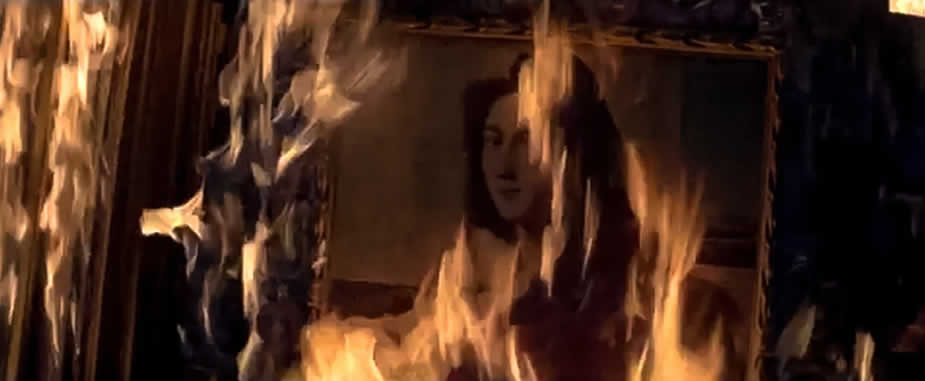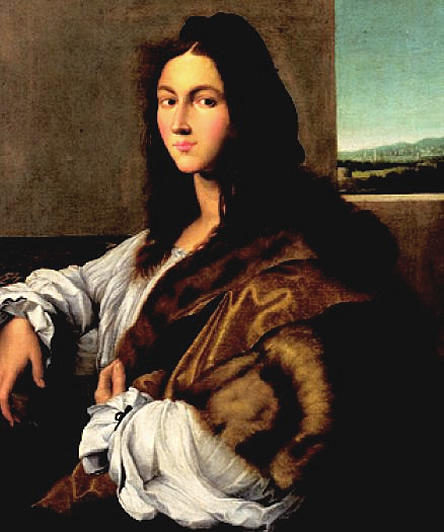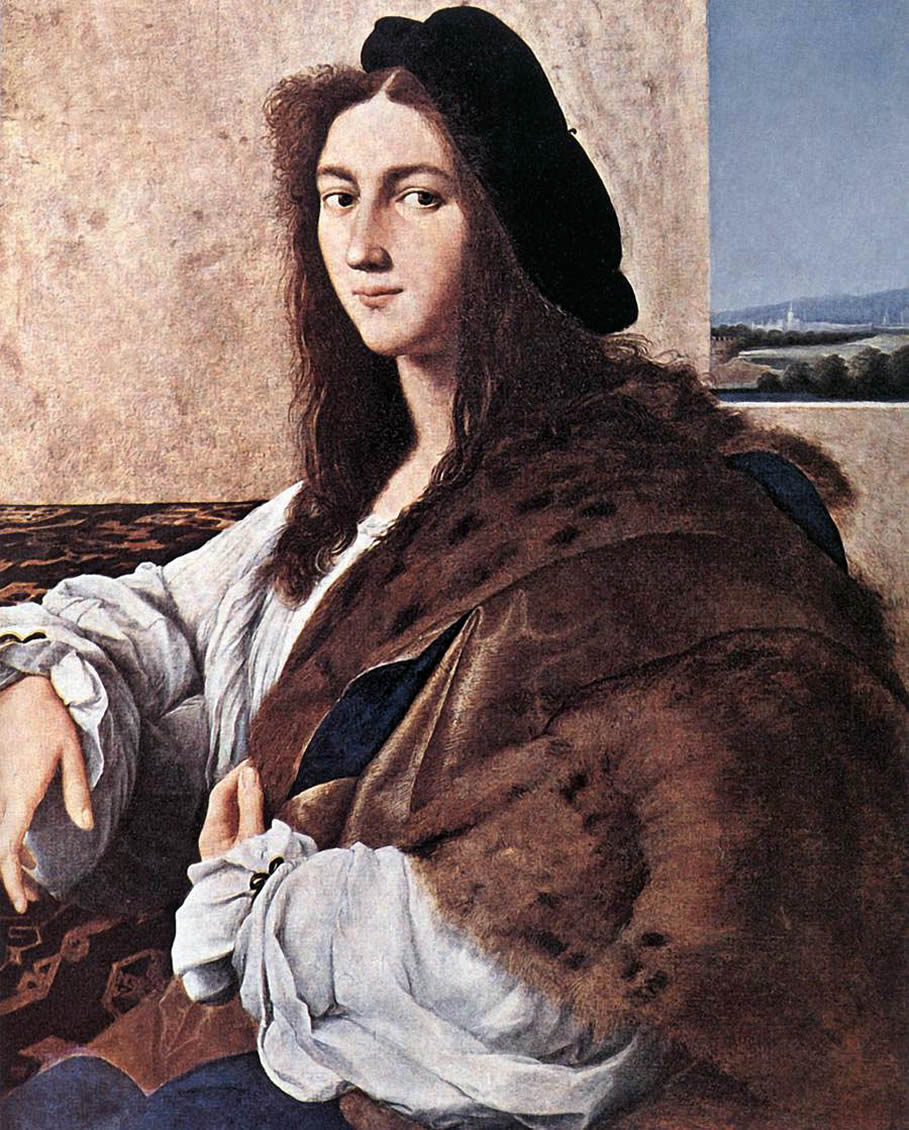Creativity,
painting, art of Raphael Santi |
|
Probable
self-portrait |
|
About
Portrait of a Young Man |
The
Nazi theft |
Copy after Raphael |
| |
|
Raphael
Santi |
| Raffaello
Sanzio Portrait of a Young Man is a painting in oil on panel, probably from 1513–1514, by the Italian High Renaissance Old Master painter and architect Raffaello Sanzio da Urbino better known simply as Raphael. The painting was stolen by the Nazis from Poland. Many historians regard it as the most important painting missing since World War II. The subject's identity is unverified, but many scholars have traditionally regarded it as Raphael's self-portrait. The facial features are perceived by specialists as compatible with, if not clearly identical to, the only undoubted self-portrait by Raphael in his fresco The School of Athens at the Vatican, identified as such by Vasari. If it is a self-portrait, no hint is given of Raphael's profession; the portrait shows a richly-dressed and "confidently-poised" young man. The painting was brought to Poland, along with Leonardo da Vinci's Lady with an Ermine and many Roman antiquities, by Prince Adam Jerzy Czartoryski, son of Princess Izabela Czartoryska, on his travels to Italy in 1798. |
| |
| The
Nazi theft At the onset of Nazi German invasion of Poland in 1939, the painting was rescued from the Czartoryski Museum of Kraków along with the Rembrandt masterpiece, and Leonardo’s Lady with an Ermine, and placed at a residence in Sieniawa. The collection was discovered with the help of Gestapo by Hans Frank, appointed by Hitler as the governor of the General Government. The three paintings used to decorate his residence in the city before they were sent to Berlin, and Dresden, to become part of the Führer's own Collection at Linz, arranged by Hitler's plenipotentiary, Dr. Posse. In
1945, Frank, a friend of Adolf Hitler, brought the paintings back
from Germany to Kraków for his own use at the royal Wawel
Castle. This is where Portrait of a Young Man was last seen. When
the Germans evacuated from Kraków in January 1945 ahead of
the Soviet offensive, Frank took the paintings with him to Silesia
and then to his own villa in Neuhaus[disambiguation needed]. The
Americans arrested Frank on May 3, 1945 pending trial for war crimes.
The Polish representative at the Allies Commission for the Retrieval
of Works of Art located some of the paintings stolen by him, and
claimed them on behalf of the Czartoryski Museum. However, the Raphael
and 843 other artifacts were missing from storage. In recent times,
a book about Nazi plunder by Lynn H. Nicholas and a documentary
film by the same title, The Rape of Europa, suggested that if the
painting were to reappear today, it would be worth in excess of
100 million US dollars. |
||
| By
many "Portrait of a Young Man" is considered to be the most
important painting missing during World War II. It was stolen by the
Nazis from Poland from the collection of the Prince Czartoryski. The collection had three highlights – Leonardo’s Lady with an Ermine, Rembrandt’s Landscape with the Good Samaritan and Portrait of a Young Man. They were hidden at a residence in Sieniawa, but was later discovered by the Gestapo, working for Hans Frank, Hitler’s appointee as the governor of the General Government. The masterpieces decorated Frank’s residence in Kraków before they were sent to Berlin, and Dresden, to become part of the Führer’s own collection at Linz, arranged by Hitler’s plenipotentiary, Dr. Posse. It disappeared somewhere on the way there. Leonardo and Rembrandt came back to Poland after the War. Nobody knows what has happened with the Raphael. From time to time some sources claim that the investigation brings new information and there is a chance that the painting is in some mysterious private collection in Germany. In the 2014 film The Monuments Men, the painting is shown being destroyed by the Germans. It is shown as a prominent painting in a large cache of stolen art stored in an unidentified cave or mine that German troops set on fire with flamethrowers. By Zuzanna Stanska, 2017 |
||
 A scene of the film shows the Raphael burning. According to Polish government (the painting belonged to the collection of Czartoryski Museum of Krakow), in 2012 it was found in a bank vault in an 'undisclosed location'. Image 20th Century Fox. |
| |
 |
Accademia
Carrara in Bergamo holds "Portrait of a Young Man" in the Muzeum Czartoryski in Cracow, which is given unanimously to Raphael and dated to his early Roman years. Apparently the picture was stolen in about 1944 by the German gauleiter or his second-in-command and then vanished without a trace; it may have been destroyed during the war or still exist in a private collection. Some black-and-white photographs survive, but only one old and very poor colour photograph which gives no indication of the picture's quality. The Accademia Carrara in Bergamo holds a very good copy dating from the early sixteenth century. This
picture, which is certainly not by Raphael's workshop but possibly
by an artist from northern Italy, gives a very vivid impression
of the pictorial merits of the vanished original, especially the
delicately nuanced colours of the dress, but also the individual
rendition of the different types of textiles. Because of its high
quality, the copy may help to identify the original should it ever
turn up again.
|
| |
|
| Copyright
© 2004 abc-people.com Design and conception BeStudio © 2014-2023 |

